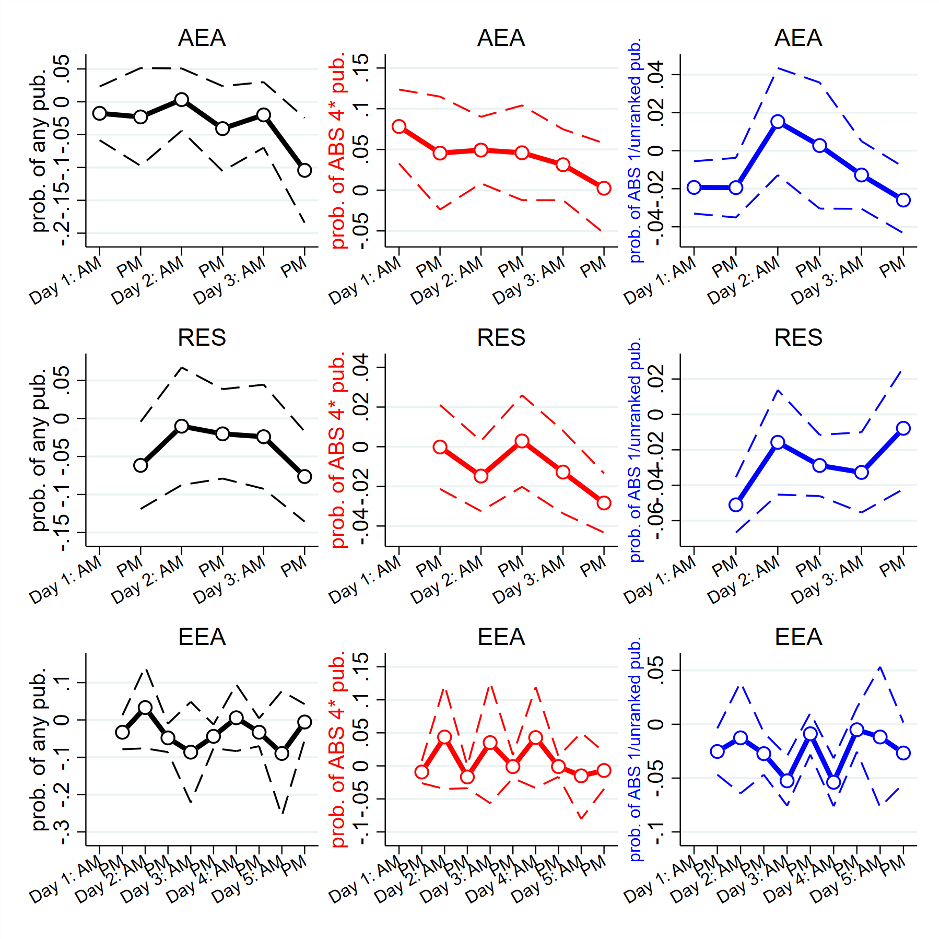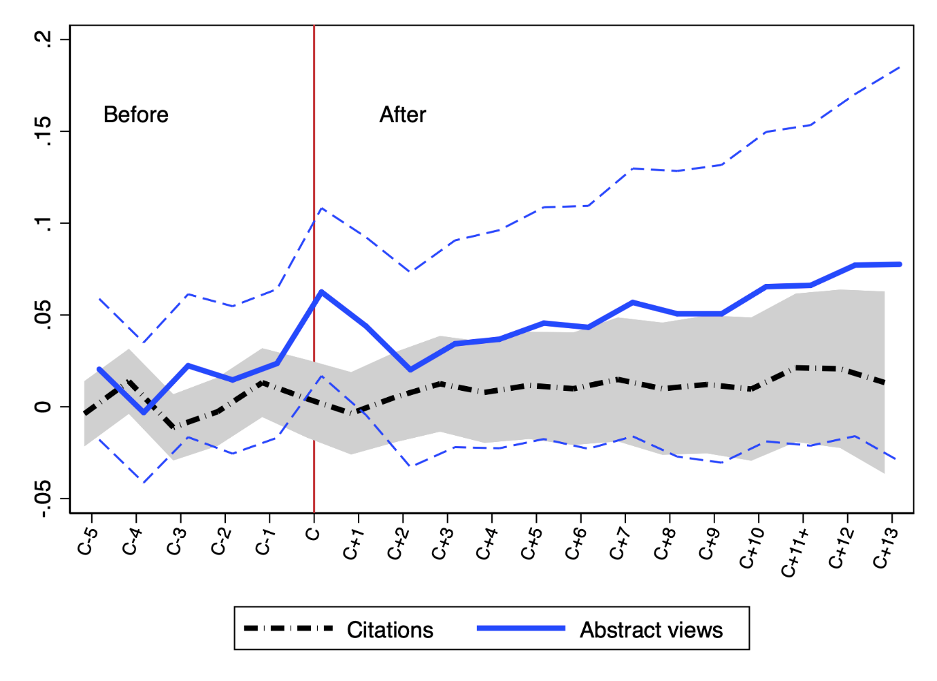Every year, thousands of economists gather for conferences organised by prominent professional societies, such as the American Economic Association (AEA), the European Economic Association (EEA), and the Royal Economic Society (RES). Although the benefits of these gatherings, such as improved productivity and visibility, have been documented in a growing number of studies (e.g. Blau et al. 2010, Campos et al. 2018, Leon and McQuillin 2018), the link between conference presentations and publication outcomes remains unclear.
In a recent study, we attempt to quantify the contribution of conference participation to publication outcomes and other metrics of academic success (Gorodnichenko et al. 2019). A comprehensive dataset of authors whose papers were presented at the annual conferences organized by the AEA, EEA, and RES over the 2006-2012 period has been assembled. This dataset, combined from the conference programmes and IDEAS/RePEC statistics, also contains information about papers from the same authors which were not presented at these events.
Conference presentations and publishing probability
When ignoring the importance of the connectedness and breadth of research teams as well as paper quality, conference presentation appears to be positively associated with publication probability. Participating in a major conference is associated with an increase of 14.7 percentage points in publication probability, which is a relatively large increase given the unconditional probability of 30%. However, once these factors are accounted for, conference participation has effectively no predictive power for publication in any academic journal. In other words, conferences appear to have little, if any, value added for generating publications.
Nevertheless, bearing in mind the variation across journals in prestige and impact, one needs to control for the quality of publishing outcomes to precisely quantify conferences’ contribution to academic achievements. Repeating our analysis with different outcomes of journal ranking based on the Association of Business Schools’ (ABS) Academic Journal Guide 2015, we find that participating in a major conference is predictive for where a conference paper might be published. Participating in a major conference does not predict a higher probability of publications in low-tier journals (unranked, ranked 1 or 2 by the ABS). At the same time, participation predicts higher probabilities of publication in high-quality journals (ranked 3, 4, or 4* by the ABS). For example, conference presentation is associated with 1.3 percentage point higher probability of publication in the premier (4*) tier of journals. This is a large increase since the unconditional probability of publication in a 4* journal is only 2.8% in our sample.
Similar to journals, conferences vary dramatically in selectivity, prestige, and attendance. In 2019, 13,450 people registered to attend the AEA conference, while 1,166 and 484 people registered for the EEA and RES conferences. Hence, one might expect variation in how successful conferences are in ‘placing’ papers in journals. Our results are consistent with this conjecture. While the zero predictive power of conference participation for publication in a low-rank journal is found for all three conferences, results for top-tier (ABS 4* rank) journals are different. Presentation at the EEA and RES conferences does not help place the paper in a top journal. On the other hand, participating in an AEA conference is associated with a 4.8 percentage higher probability of publication in a 4* journal, which is approximately double (!) the unconditional probability.
Prime time
What is the best time to present a paper? Ideally, researchers should discover the true value of a presented study irrespective of whether they are tired after a long day, sleepy in the morning after a jet lag, or fresh and bright after a large cup of coffee. However, it is not surprising to find that a session scheduled in the last slot of the last day of a conference entails a smaller audience and, thus, presumably a lower impact.
Figure 1 shows that indeed, the time and day of a paper presentation predict how well the paper will fare in journals. For instance, a paper presented in the last slot at the AEA and RES conferences has the lowest probability of publication in any journal. Meanwhile, presenting in the morning of the second day tends to be associated with the highest probability of publication. Although a similar pattern is not observed for the EEA conference, we see that mornings of the first three days of the conference tend to have positive point estimates for publications in top-tier journals.
Figure 1 Publication outcomes and time and day of presentation
Notes: This figure presents results for the link between conference presentations by conference time and the probability of being published. The solid black, red, and blue lines show the estimated coefficients on TimeDayConferencep,a,c,τ in the estimations with publications in any journal (left column), in ABS 4* journals (center column), and in ABS 1 journals (right column) as the outcome, respectively. TimeDayConferencep,a,c,τ equals one if paper p with authors a was presented in conference c at time slot τ (presented in the horizontal lines). The dashed lines indicate 1.96 standard error confidence intervals.
Conference presentations and publishing in high-quality journals: Women versus men
To contribute to the literature documenting the difference in productivity and career advancement between female and male academics (e.g. Albert et al. 2016, Ginther and Hayes 2003, Kahn 1993, Maske et al. 2002, Lundberg and Stearns 2019), we examine whether the impact of conference presentations on publishing for female authors is different from that for male counterparts. We find that participation in a major conference does not predict a higher probability of publication in any academic journal or in low-tier journals (unranked, ranked 1 or 2 by the ABS) for both female and male authors. However, presented papers by male authors experience a higher likelihood of being published in top journals. At the same time, the probability of being published in high-quality journals for female researchers’ presented papers is next to zero. While our results are not causal, the statistics still show a potentially troubling picture. Female authors appear to gain less at the top end of journal hierarchy after presenting their work in major conferences, even after controlling for basic heterogeneity in research profiles of authors.
Other academic success indicators
Complementing previous studies, we also document the contribution of conference participation to other measures of success, such as the visibility and impact of the presented papers. We use the number of abstract views as the visibility indicator and the number of citations as the impact indicator. Figure 2 suggests that, in the conference month, a paper would receive a 6 percentage point boost in the number of abstract views compared to the number of monthly abstract views received before. The increase in the following month is about 4 percentage points.
Figure 2 Dynamics of citations and abstract views before and after a major conference
Notes: This figure presents results for the influence of conference presentations on research impact and visibility which are indicated by the number of monthly abstract views and citations. The estimated coefficients on Conferencep,c,m-τ are represented by the solid blue line and the solid black line for estimations with the number of abstract views and citations respectively. τ is the time of conference c where paper p was presented at, and m is calendar month. The dashed lines indicate confidence intervals at 5% significant level. In the horizontal axis, C refers to conference. The red vertical line represents the conference month.
Conclusion
Our findings highlight the importance of conference presentations for research productivity and promotion. Although our analysis only focuses on the narrow outcomes of journal publication and thus does not necessarily provide a complete picture of a conference’s value, our results clearly indicate that academic institutions should have effective mechanisms to encourage and support researchers to present in the high-quality conferences. By doing so, both researchers and universities can benefit from improved research performance (more publications in high-quality journals) and increased research dissemination (higher visibility).
References
Albert, C, M A Davia, and N Legazpe (2016), "Determinants of research productivity in Spanish academia", European Journal of Education 51(4): 535-549.
Blau, F D, J M Currie, R T Croson and D K Ginther (2010), "Can mentoring help female assistant professors? Interim results from a randomized trial", American Economic Review 100(2): 348-52.
Campos, R, F Leon and B McQuillin (2018), "Lost in the storm: The academic collaborations that went missing in hurricane Issac", The Economic Journal 128(610): 995-1018.
Ginther, D K and K J Hayes (2003), "Gender differences in salary and promotion for faculty in the humanities 1977–95", Journal of Human Resources 38(1): 34-73.
Gorodnichenko, Y, T Pham and O Talavera (2019), "Conference presentations and academic publishing", NBER working paper 26240.
Kahn, S (1993), "Gender differences in academic career paths of economists", American Economic Review 83(2): 52-56.
Leon, F and B McQuillin (2018), "The role of conferences on the pathway to academic impact: Evidence from a natural experiment", Journal of Human Resources 1116-8387R.
Lundberg, S and J Stearns (2019), "Women in economics: Stalled progress", Journal of Economic Perspectives 33(1): 3-22.
Maske, K L, G C Durden and P E Gaynor (2003), "Determinants of scholarly productivity among male and female economists", Economic Inquiry 41(4): 555-564.








